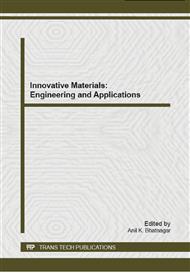[1]
Chang F K, Lessard L B. Damage tolerance of laminated composites containing an open hole and subjected to compressive loadings. I: Analysis[J]. Journal of Composite Materials, 1991, 25(1): 2-43.
DOI: 10.1177/002199839102500101
Google Scholar
[2]
Tserpes K I, Papanikos P, Kermanidis T. A three‐dimensional progressive damage model for bolted joints in composite laminates subjected to tensile loading[J]. Fatigue & Fracture of Engineering Materials & Structures, 2001, 24(10): 663-675.
DOI: 10.1046/j.1460-2695.2001.00424.x
Google Scholar
[3]
Papanikos P, Tserpes K I, Labeas G, et al. Progressive damage modelling of bonded composite repairs[J]. Theoretical and Applied Fracture Mechanics, 2005, 43(2): 189-198.
DOI: 10.1016/j.tafmec.2005.01.004
Google Scholar
[4]
Liu X, Wang G. Progressive failure analysis of bonded composite repairs[J]. Composite Structures, 2007, 81(3): 331-340.
DOI: 10.1016/j.compstruct.2006.08.024
Google Scholar
[5]
Chang K Y, Llu S, Chang F K. Damage tolerance of laminated composites containing an open hole and subjected to tensile loadings[J]. Journal of Composite Materials, 1991, 25(3): 274-301.
DOI: 10.1177/002199839102500303
Google Scholar
[6]
Zhen W, Wanji C. Stress analysis of laminated composite plates with a circular hole according to a single-layer higher-order model[J]. Composite Structures, 2009, 90(2): 122-129.
DOI: 10.1016/j.compstruct.2009.02.010
Google Scholar
[7]
Hu F Z, Soutis C, Edge E C. Interlaminar stresses in composite laminates with a circular hole[J]. Composite structures, 1997, 37(2): 223-232.
DOI: 10.1016/s0263-8223(97)80014-1
Google Scholar
[8]
Carlsson L. Interlaminar stresses at a hole in a composite member subjected to in-plane loading[J]. Journal of Composite Materials, 1983, 17(3): 238-249.
DOI: 10.1177/002199838301700305
Google Scholar
[9]
Maa R H, Cheng J H. A CDM-based failure model for predicting strength of notched composite laminates[J]. Composites Part B: Engineering, 2002, 33(6): 479-489.
DOI: 10.1016/s1359-8368(02)00030-6
Google Scholar
[10]
Sugiman S, Crocombe A D, Katnam K B. Investigating the static response of hybrid fibre–metal laminate doublers loaded in tension[J]. Composites Part B: Engineering, 2011, 42(7): 1867-1884.
DOI: 10.1016/j.compositesb.2011.06.013
Google Scholar
[11]
Linde P, Pleitner J, de Boer H, et al. Modelling and simulation of fibre metal laminates[C]/ABAQUS Users' conference. 2004: 421-439.
Google Scholar
[12]
Hashin Z. Failure criteria for unidirectional fiber composites[J]. Journal of applied mechanics, 1980, 47(2): 329-334.
DOI: 10.1115/1.3153664
Google Scholar
[13]
Katnam K B, Sargent J P, Crocombe A D, et al. Characterisation of moisture-dependent cohesive zone properties for adhesively bonded joints[J]. Engineering Fracture Mechanics, 2010, 77(16): 3105-3119.
DOI: 10.1016/j.engfracmech.2010.08.023
Google Scholar


